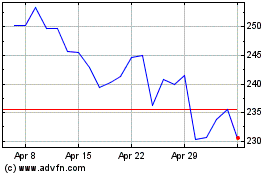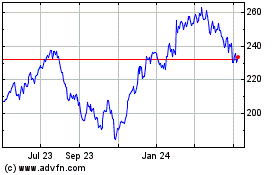Companies' Financial Planning Comes Up Short in the Coronavirus Era
May 24 2020 - 9:29AM
Dow Jones News
By Mark Maurer and Nina Trentmann
To prepare for uncertainty, finance chiefs turn to scenario
planning. They develop models to help quantify the effects of
what-if situations involving cash flow, sales revenue and other
metrics.
However, the unprecedented nature of the coronavirus pandemic
has complicated the practice, upending annual budgets and
investment time lines, and rendering forward-looking guidance
futile.
CFOs in recent weeks have set aside pre-existing plans or are
treating them, at best, as a starting point. Some companies have
opted to draw on the fallout of the 2008 financial crisis as a de
facto worst-case scenario.
But unlike past crises, many executives find every element of
their business under strain.
"You've got these great plans and as of yesterday, they're
completely meaningless," said Brian Kalish, who consults on
financial planning and corporate treasury issues.
As the pandemic drags on, finance chiefs across sectors are
devoting more time and resources to examining a range of potential
scenarios. They are also stress-testing business-continuity plans
and trying to revise forecasts more frequently.
"We just don't know what we're facing," said Mark George, chief
financial officer of Norfolk, Va.-based railroad operator Norfolk
Southern Corp.
Norfolk Southern last year started relying on stress-test
scenarios to test its liquidity and gauge if it was positioned to
deal with another crisis such as the 2008 downturn, Mr. George
said. The company's finance team imagined scenarios using varying
multiples of revenue and then simulated the impact of that revenue
on cash flow. Those exercises are helping the company evaluate
possible outcomes, he said.
"Part of this is driven by, frankly, the PTSD we all have going
back to the 2008 financial crisis," he said.
Many CFOs, therefore, hesitate to stick to their predictions for
the coming quarters. Sixty-two percent of S&P 500 companies
have withdrawn or revised earnings guidance since April 1 because
of the pandemic, according to research and advisory firm Gartner
Inc.
Policy makers and company executives increasingly expect a
swoosh-shaped recovery, denoting a large drop in the economic
performance followed by a prolonged return. But economists continue
to consider a variety of possibilities, such as a short collapse
followed by a bounce back to pre-pandemic levels of activity, or a
slower version of gross domestic product recovery.
"The world is going to be different in three, six and 12
months," said Christopher Kastner, CFO of Newport News, Va.-based
shipbuilder Huntington Ingalls Industries Inc. "Thinking through
what's going to be next, I know that's hard to do and we're
challenged with it."
The unpredictability has made even worst-case scenarios
revolving around natural disasters seem suddenly manageable.
"A hurricane you can see the other side of, so it's easier to
plan when you're going to come back up the other side and how
you're going to execute," Mr. Kastner said.
As companies tighten their budgets, models and planning tools
aren't expected to undergo significant innovation. Businesses
likely will continue to use planning tools they already have
because it is very difficult to develop new tools in the midst of a
crisis, said Bryan Lapidus, director of the financial planning and
analysis practice for the Association for Financial
Professionals.
Group 1 Automotive Inc., is examining scenarios covering a
12-month period, said CFO John Rickel. Its parts and services
business division was particularly resilient during the 2008
financial crisis as people held on to their vehicles longer and
needed repairs and service, but is facing declines now, he
said.
The pandemic has pushed the Houston-based dealership chain to
test out worst-case scenarios that would be worse than anything
tested before the current crisis, Mr. Rickel said, such as a 30% to
40% decline in revenue for its parts and services division.
Group 1 is swiftly adjusting by focusing on the potential impact
on costs, cash and loan agreements. It has developed a strategic
plan to reduce capital spending and suspend its dividend, he
said.
"You want to be in a position where if those more dire forecasts
come through," said Mr. Rickel, "you're not putting the business at
risk."
Write to Mark Maurer at mark.maurer@wsj.com and Nina Trentmann
at Nina.Trentmann@wsj.com
(END) Dow Jones Newswires
May 24, 2020 09:14 ET (13:14 GMT)
Copyright (c) 2020 Dow Jones & Company, Inc.
Norfolk Southern (NYSE:NSC)
Historical Stock Chart
From Mar 2024 to Apr 2024

Norfolk Southern (NYSE:NSC)
Historical Stock Chart
From Apr 2023 to Apr 2024
